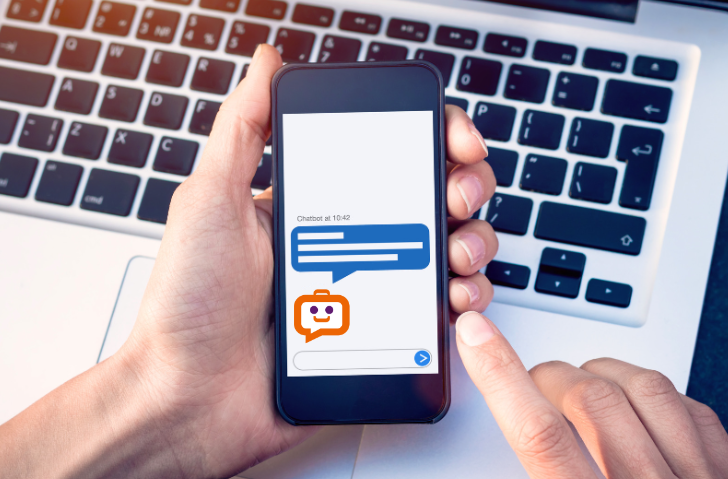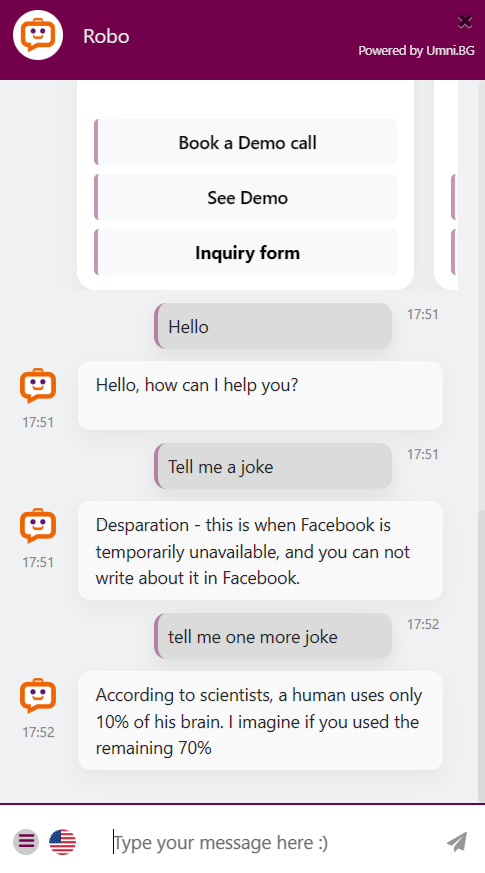 Conversational AI is a relatively new concept and a true buzzword in the business world. What is Conversational AI, and how can you properly train it for your chatbot? Conversational AI is a type of artificial intelligence that is designed to mimic human conversation. It can be used for customer service and support, for sales and marketing, or even for personal use. The definition of conversational AI according to Gartner is “an AI technology that enables natural conversations between humans and digital devices or systems.” In other words, it’s the process of making a chatbot or digital assistant sound more like a human. Now, with the trends around ChatGPT – a language model that was called by the media an AI chatbot and therefore became the most famous AI chatbot, you must know that a conversational AI module trained by your team is different from ChatGPT, and in the next paragraphs, you will learn how to train your own business AI chatbot.
Conversational AI is a relatively new concept and a true buzzword in the business world. What is Conversational AI, and how can you properly train it for your chatbot? Conversational AI is a type of artificial intelligence that is designed to mimic human conversation. It can be used for customer service and support, for sales and marketing, or even for personal use. The definition of conversational AI according to Gartner is “an AI technology that enables natural conversations between humans and digital devices or systems.” In other words, it’s the process of making a chatbot or digital assistant sound more like a human. Now, with the trends around ChatGPT – a language model that was called by the media an AI chatbot and therefore became the most famous AI chatbot, you must know that a conversational AI module trained by your team is different from ChatGPT, and in the next paragraphs, you will learn how to train your own business AI chatbot.
As digital devices and systems become more and more common to use in our everyday lives, it’s important that they can communicate with us in a way that feels more natural and human-like, and conversational AI could help. Chatbots are projected to see over a 100% increase in their implementation and usage in the next 2 to 5 years. They are the leading AI use cases in businesses today. Gartner revised the chatbots’ implementation rate from a range of 5% to 20% in 2019 to 20% to 50% in 2020. The chatbot market and the conversational AI market size will continue to grow due to the demand for solutions in the areas of digitalization, automation, and self-service.

Details of what’s new in Gartner’s hype cycle for artificial intelligence, 2020
There are various instruments to train conversational AI – standalone that need integration with the chatbot, or built-in and simple to use as it is on the Umni platform, but the most important thing is to focus on creating realistic conversations which include many details such as analyzing customer questions, creating small talks (for all those curious to test the chatbot taste of humor or if it knows your grandma’s brownie recipe), using a specific tone of voice and other. It is important also to use real-life data to train properly the conversational AI module for your chatbot.
Why Proper Training is Important for Conversational AI
 As any project needs to be planned properly to be effective, the training of a conversational AI is not an exception. Before to start training your chatbot AI module, you shall consider some tips, tricks, and good practices of the conversational AI working with other chatbot elements, so the conversational AI would work properly to meet your business goals and needs. This shall be not a standalone planning project but an important part of the overall and detailed AI chatbot project planning.
As any project needs to be planned properly to be effective, the training of a conversational AI is not an exception. Before to start training your chatbot AI module, you shall consider some tips, tricks, and good practices of the conversational AI working with other chatbot elements, so the conversational AI would work properly to meet your business goals and needs. This shall be not a standalone planning project but an important part of the overall and detailed AI chatbot project planning.
There are many reasons why proper training is important. First, it helps to ensure that the conversational AI module can recognize the user input and deliver the correct answer. This is essential for effective online communication. Second, the proper training includes the fine-tuning of the conversational AI module – which means, learning from the customers’ behavior and questions. This helps the business to further provide more accurate information and personalized actions based on customers’ searches. Also, the continuous analyses and training of the AI module help to better understand customers’ problems and needs, predict trends, as well as to add more topics and small talk conversations so customers would feel like they are talking to a human that can assist them further. Assigning a person or a team is also important to take care of the training and then testing the conversational AI module to have good understanding of the technology and know well the chatbot functionalities and content, therefore maximizing the benefits from the chatbot for the business, its customers, and employees. Almost 8 out of 10 users will back out from buying from a business if their customer service is poor, whereas more than 9 out of 10 (93%) users will shop or communicate with a company again if its support is top-notch! That’s why when considering implementing an AI chatbot on your site, your team shall ensure the user experience is the best!
If the AI module is not trained properly, it will not be able to understand the user and will not be able to provide the correct responses. This will lead to a poor customer experience, lost business opportunities, and could affect negatively in a long term the brand’s reputation. So, if you take the time to properly plan and train your conversational AI, you’ll be rewarded with a powerful tool that can help you automate customer interactions and improve your overall business processes, products, and services.
How to Properly Train Your Conversational AI: Tips and Tricks to Get the Most Out of Your Investment
 There are a few things you need to keep in mind when training your conversational AI. First, you need to clearly define your goals. What do you want your conversational AI to achieve? What topics it will cover? To what information or call to action it will refer? Next, you need to create a realistic training scenario and schedule. This will help you ensure that the conversational AI can handle different types of customer interactions and your team will know when to expect it to do it. Finally, you need to monitor your chatbot conversational AI’s performance and adjust as needed.
There are a few things you need to keep in mind when training your conversational AI. First, you need to clearly define your goals. What do you want your conversational AI to achieve? What topics it will cover? To what information or call to action it will refer? Next, you need to create a realistic training scenario and schedule. This will help you ensure that the conversational AI can handle different types of customer interactions and your team will know when to expect it to do it. Finally, you need to monitor your chatbot conversational AI’s performance and adjust as needed.
The key to properly training Conversational AI is to collect and use a lot of data. The more conversational and customer behavior data you have, the better it will be for your AI chatbot at imitating human conversations. Here are a few suggestions on how to do it to aim for perfection in chatbot communication:
1. Use a dataset that you already have
You could already have a dataset of your top customer questions and needs collected from e-mails, social media, live chat conversations, phone calls, surveys, and other sources. You can analyze them and use them to train your chatbot conversational AI. This is the easiest path to get started, but you need to have at least the top 100 specific business topics in addition to the small talk (greetings and general questions like location, telephone number, hours of operations, and others) to give a good start to your chatbot with conversational AI. Keep in mind that the data must be updated to the relevant situation of your business to meet all your customers and business needs.
If you do not have such a conversational dataset, don’t worry. Move to the next suggestion.
2. Create a new conversational collection
If you want to ensure that your conversational AI is as accurate as possible and you didn’t have your own ready dataset, you will need to create one from scratch to start properly. This is a bit more work, but it will be worth in the end. You can start by brainstorming with your team what are the most frequently asked question asked and start collecting the new customer questions through all communication channels your business use. Start with the 100 top frequently asked questions your team can come up with, also based on the analyses of the company’s social media channels, messengers, e-mails, and phone calls in the past 3 to 6 months, and then continue with more every day, week or month when new topics are identified. Sort them by topics to train your AI chatbot to them for it clearly understand your customers and give them instantly the most relevant answers.
3. Use a mix of both
You can also use a mix of old and newly created datasets. This will give you the best of both worlds: use at least 6 months old customer information – scrab the existing questions from social media, emails, live chat records, messengers, and other available channels, and start collecting the newest so to not miss any trendy topics unanswered and to not leave customers unsatisfied.
4. Training your conversational AI chatbot – the success is in the details
 Once you have your company data, it’s time to start training your Conversational AI. There are a few key things to keep in mind when training conversational AI for your chatbot.
Once you have your company data, it’s time to start training your Conversational AI. There are a few key things to keep in mind when training conversational AI for your chatbot.
First, you need to ensure that the topics are clearly defined and do not repeat themselves, so the conversational AI in the chatbot would provide the most correct answers.
Second, you need to plan things like tone of voice, context and emojis. How you train your AI chatbot to answer is what perception of your brand will have customers while communicating with your business online. The tone of voice in the answers is also important. It can be friendly, witty, professional, funny, or others. That’s what your customers will think of your business, what emotion it will create, and what they will remember about it. All answers should be in favor of the business, brief and not too pushy, and committed to assisting customers and making an extra step in their service. If your AI chatbot will have a male or female personality, you should also decide how he or she would talk to customers. Here are some research on the topic and the best practices for choosing an avatar, a name, and your chatbot personality that would help provide proper answers in the conversational AI module. The emojis are no less important: if you use such in your social media and other channels to represent your business then you shall use the same in your chatbot for proper brand awareness.
Third, you need to ensure that you will write the answers for the conversational AI module in a consistent manner, with proper grammar and sentence structure. Keep in mind to not give one-word answers, as on the screen of the mobile phone this feels unpleasant and unprofessional. The conversation may be over too soon, which means missing opportunities for customer engagement, sales, and conversions. It is a good practice to answer to the content of the paraphrased question in it so the customer will be sure that the AI chatbot had answered his or her question. This will help also the customer understand if the chatbot did a mistake and provided an answer to a different question. If every answer provides valuable information, even the mistaken answers will be helpful to your customers.
As we talk here about the answers, one more good practice is to use negative answers as an opportunity to provide customers with information about existing alternatives. Instead of saying your business doesn’t provide a certain service or does not have a certain product, write an answer that focuses on their alternative and the benefits that your business will provide with it to the customer.
Fourth, you need to train the conversational AI on as many training phrases as you could think of that the customers could ask to cover the variety of words and ways customers could ask a certain question. For example, you are training your AI chatbot on the topic of the benefits of your products and services – customers can ask questions such as what the benefits of your products are, what are the advantages of your products, what are the pros of your products, what value your products give and etc. Think how many different ways people can ask the simple question “How are you” – “What’s up?”, “How have you been?”, “How it’s going?”, “How are things going” etc. You can see how many options customers have to ask one question. You need to train your AI chatbot on all the phrases on one topic that comes to your mind that a customer could ask using also a specific jargon your target customers may use. By doing this you would ensure that your AI chatbot would recognize faster more of the customer questions and will give the correct answers. You also could give not one but a variety of answers to one question, so customers won’t feel bored. For example, they want the chatbot to tell a joke and then another one – they would ask for as many as they want, so make sure to provide more in the replies section to keep them satisfied.
Fifth, you need to know that the AI chatbot can learn from its conversations and every time there is an unanswered question or a mistake, it gives you the opportunity to train it further so future customers will receive the answer. Make sure you have planned time for this additional training and fine-tuning, as well as for analyzing the collected questions to not miss any opportunity for new trends, products, and services.
These are just a few of the things to remember when training conversational AI. By following these guidelines, we can ensure that the conversational AI in your chatbot is used and trained properly, and in favor of your business.
With the right approach, conversational AI can help your business scale support, boost customer satisfaction, reduce churn rates and provide better products and services overall by better knowing your customers’ behavior in the chatbot and making intelligent decisions based on the collected through the chatbot data.
If you have time to read more, here are a few more good practices and details on how to plan and train your chatbot with conversational AI to work in favor of your business, customers, and employees:
Train your AI chatbot on FAQ to battle routine
Once you have all the data about your customers’ behavior, search, interests, and questions collected for some time on your website, on social media, or elsewhere, you shall organize it into most frequently asked questions and topics and train the AI chatbot to answer them. By doing this, you will automate the customer service and support, assign FAQs to this self-service tool, and release your employees from the routine. An example of a frequently asked question is what the prices of your products are, how to return a product, what are the delivery specifics, common issues that a customer can have, and many more that often customers ask. Website visitors and chatbot users expect that information as soon as possible to become and stay your client and not search for an alternative.
Train your AI-powered chatbot on all the topics that your customers ask, spend some time on a daily (or at least weekly) basis to check and follow up on what happens in the chatbot to make sure it gets its continuous training, upgrades, and further content development to satisfy your customers. One of the largest tour operators in the Balkans, TEZTour saved 850 working hours to the staff in the very first 10 months of its chatbot implementation.
Train your AI chatbot on small talks
 The importance of the small talks is for customers to feel the conversation more human-like and emotional and to not recognize that they chat with a chatbot. You can train the AI chatbot to greet customers, tell funny jokes, say thank you and goodbye, or relevant to your business small talk topics. You can train your chatbot on how to answer topics such as compliments or existential questions. You can even teach your bot on how to handle rude and aggressive words from customers – it happens to the employees of all businesses occasionally to handle a conversation with such customers. Use the AI chatbot to deal with them in a polite and calm way to give them what they want right away.
The importance of the small talks is for customers to feel the conversation more human-like and emotional and to not recognize that they chat with a chatbot. You can train the AI chatbot to greet customers, tell funny jokes, say thank you and goodbye, or relevant to your business small talk topics. You can train your chatbot on how to answer topics such as compliments or existential questions. You can even teach your bot on how to handle rude and aggressive words from customers – it happens to the employees of all businesses occasionally to handle a conversation with such customers. Use the AI chatbot to deal with them in a polite and calm way to give them what they want right away.
The small talk answers are a must if you want to keep your customers satisfied and thank you for the assistance. The Umni platform provides a pretrained small talk set, feel free to ask our team to load it to your AI chatbot when you start training it on the Umni platform. Don’t forget to customize and personalize the answers in this or other pretrained sets to your business and customers’ needs. Umni also has a pretrained hotel AI module that instantly recognizes and answers 760+ hotel topics with 10,400+ customer questions behind which means the AI chatbot starts working from day 1. Additionally, now Umni provides also voice assistance (speech recognition) in Bulgarian and English for faster and easier communication. Our clients the 5-star hotel Casa di Fiore Medical & Spa and the hotel complex Izgreva are already using it and achieve better results each month.
Use conversational AI answers to redirect to specific content in your chatbot
Did you know that conversational AI can not only be used to answer potential or current customers with a short text, which means taking care of the frequently asked questions instantly, but also it can redirect automatically to more information on the topic with calls to action buttons or forms? At least, this can happen on the Umni platform.
Redirects from the answers provided by the conversational AI module in the chatbot to other chatbot elements are used when the answer to a customer question would contain too much information or would require further action from the customer. It is like building mini funnels inside the chatbot with the help of conversational AI that are personalized according to the customer search.
It is a good practice instead of squeezing everything into one text block in the AI answer that is too long to read, to divide the answer into a carousel with different sections with images, additional detailed information, and buttons: for external info such as video, pdf file, link to a webpage, of to a form. By doing that, the business can create an entire funnel inside of the chatbot triggered by the customer question – the conversational AI module provides a brief answer and directs further the customer to a carousel where the answer is not only provided in detail but there is also a button or more information with a link to a reservation system, meeting scheduling, inquiry form or others call-to-action. For the business, this is an opportunity to sell a product or service and for the customer, it is all about convenience and interaction. He or she won’t need to go somewhere else to do the certain action – it all can happen in the AI chatbot.
Another way to use a redirect from an answer by the conversational AI module is to a form for customers to fill out – for collecting customer data for marketing and sales purposes, for service inquiry, subscribing to a newsletter, signing up for a webinar, or anything else that a business wants its customers to do.
Keep yourself updated on the good practices, tips, and tricks used in the conversational AI chatbots and use them in your AI chatbot to make sure it over-delivers and exceeds your customer expectations, and you will for sure enjoy the “Thank you” message at the end of their conversation with your digital assistant. Isn’t it something that every business wants – all customers to be satisfied with the brand and its products and services and to become loyal for life.
How to Properly Evaluate the Performance of Conversational AI
 Once you have trained your conversational AI, you need to test it. The best method to do this is to use it in a real-world situation. This will help you see how it performs in a real-world setting and make sure that it is working properly. Use your employees, friends, family members, partners, and focus groups to test it before releasing the AI chatbot so if you see any mistakes correct them before launching it to the world. New training topics for sure will pop up too!
Once you have trained your conversational AI, you need to test it. The best method to do this is to use it in a real-world situation. This will help you see how it performs in a real-world setting and make sure that it is working properly. Use your employees, friends, family members, partners, and focus groups to test it before releasing the AI chatbot so if you see any mistakes correct them before launching it to the world. New training topics for sure will pop up too!
The rule about learning from our mistakes does not apply in the AI chatbot – correct the mistakes quickly to avoid a bad impression on the brand, and after the launch, observe the chatbot’s answers to correct them accordingly. If customers find mistakes or issues before your team, react fast so they will be satisfied with their AI chatbot experience.
The Conversational AI Technology is Poised to Revolutionize the Global Markets
Conversational AI technology is already revolutionizing the global markets. The global conversational AI market size is projected to reach $32.62 billion by 2030, registering a Compound Annual Growth Rate (CAGR) of 20.0% from 2021 to 2030, according to Allied Market Research. The major factors driving the growth of the conversational AI market are the increasing demand for AI-powered customer support services, omnichannel deployment, and reduced chatbot development costs, according to the Markets and Markets report.
Want to revolutionize your business? Hurry up and contact us to provide you access to our platform to train your own chatbot with conversational AI and get the most of it before your competitors! Start now to improve your business processes tomorrow!